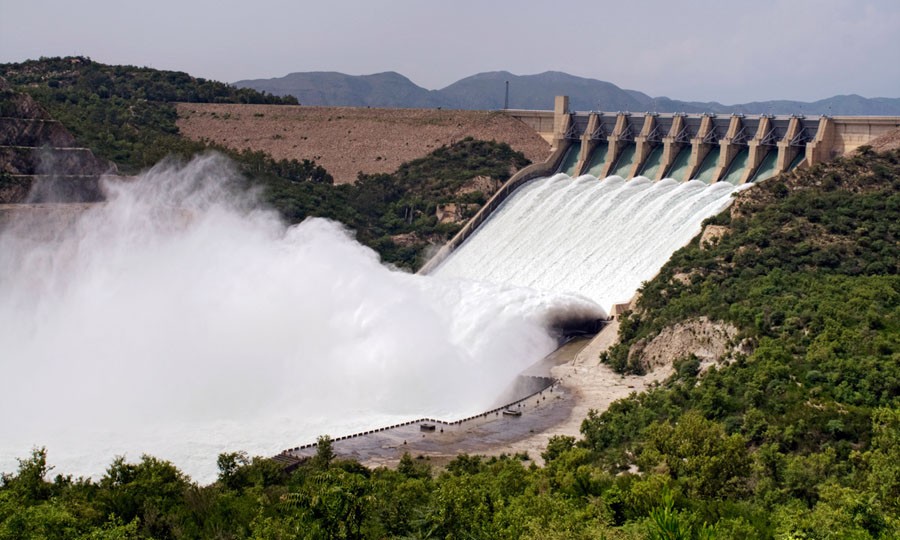
Is the building of dams and reservoirs the only solution to our water and power shortages?

In the recent years, there has been an increased emphasis on the construction of dams in Pakistan. Whether it is the issue of adequate water storage, or power generation or the agricultural aspect, these problems are being linked to the construction of dams as the ultimate solution. Is the building of dams and reservoirs really the only solution? And if it is, then are there some aspects being compromised by the construction of dams?
The need for dams and reservoirs mainly arose following the Indus Water Treaty signed between India and Pakistan in September 1960. Under this treaty, the control of eastern rivers was given to India. Consequently, an intricate system of canals, barrages, dams and reservoirs was created, which diverted water from Indus, Jhelum and Chenab to compensate for the water loss in the areas initially fed by the eastern tributaries.
In the present time, the topic of expansion of agricultural, industrial and power generation sectors, through the construction of dams and reservoirs on River Indus, is given immense significance. However, the trade-offs by the construction of dams cannot be ignored. It is crucial to have an in-depth analysis of the long run consequences, rather than a superficial emphasis. The communities living in Indus delta are of the view that the construction of dams would further reduce the supply of freshwater and it would have detrimental impacts on coastal ecosystem including biodiversity of the area.
Occupying an area of 600,000ha, the triangular shaped Indus Delta is the fifth largest delta in the world. It is situated between the borders of Pakistan and India, and is built-up by large quantities of silt discharged by River Indus. Possessing an extensive system of creeks, mudflats and mangrove forests, the ecosystem of Indus Delta is extremely rich in nutrients. These nutrients provide a nursery and an early feeding ground for a large variety of fish and shrimp.
Unfortunately, the water diversions in different forms have affected water flows reaching the coastal region of Sindh. The downstream flow of Kotri barrage has remained drastically low during recent years. Not only has the flow of fresh water reduced due to various dams and barrages, but the annual silt discharge has also faced serious reduction. The emphasis on economic and industrial aspect of the nation has paved the roads to severe environmental and social damages.
The consequences of human interventions have been manifested in reduction of mangrove coverage, declining fish stocks, shrinking agricultural land and vegetation, and significant reduction in livestock grazing areas. These detrimental effects have in turn put social pressures on the coastal communities. The poverty ridden local communities rely on fishing and agriculture as their main source of income. With reduced water supply, the amount of fish catch is on decline.
The shrinking ecosystem has seriously affected economic productivity, including decrease in Palla fish breeding and catch, riverine forest products and loss of wildlife species. Moreover, lesser nutrients in the deltaic regions make that land unsuitable for agricultural purposes. Resultantly, many local people have already been migrating to towns or cities due to decline in natural resources and dearth of income generation opportunities.
On the other hand, large hydropower projects are incredibly risky as they have massive impacts. They can also pose serious threat to the nearby communities as well. Dams are also challenging to manage for under-resourced countries like Pakistan.
There are indeed many benefits of dams. However, it is crucial to realise that the negative implications and consequences of this particular human intervention outweighs the positive aspects.
This raises various questions when the construction of dams is given more importance. One can come up with alternative methods that can serve the same purpose. For instance, the issue of power generation could be solved by installing solar panels. Their installation will take lesser time compared to the construction of dams, and these panels do not pose potential threats to the environment or the communities that are at a risk of being flooded otherwise. Moreover, they need not be repaired and maintained as frequently as dams, making them cost effective. Apart from solar panels, wind turbines can also be used to serve the same purpose, thereby protecting the non-renewable resources.
In case other options do not work and construction of dams is urgent, then sustainability of such developments should be ensured. Organisations like WWF express their opposition to unsustainable dams that do not adhere to internationally recognised principles and criteria. They are of the view that dams or water infrastructure should take into consideration social and environmental impacts before they are launched.
Nevertheless, it is extremely important to understand that construction of dams should be considered as the last resort. With already existing negative impacts of deforestation and the resulting climate change, human intervention pertaining to construction of dams will only make the matter worse.
The local communities of the coastal region are already facing severe financial crisis to due pollution and low water levels. They do not get enough fish catch to satisfy their financial needs. The land is also increasingly being made unsuitable for agriculture. Construction of dams would not only lead to further degradation of these aspects, but will also pose a potential threat of flooding to the communities living in their surroundings. Moreover, the story will not end after the construction of dam. It will require frequent repair and maintenance, which would mean frequent investment. This in-turn does not make it a cost-effective option of a developing country like Pakistan.